2006 VOLKSWAGEN GOLF PLUS steering
[x] Cancel search: steeringPage 200 of 541
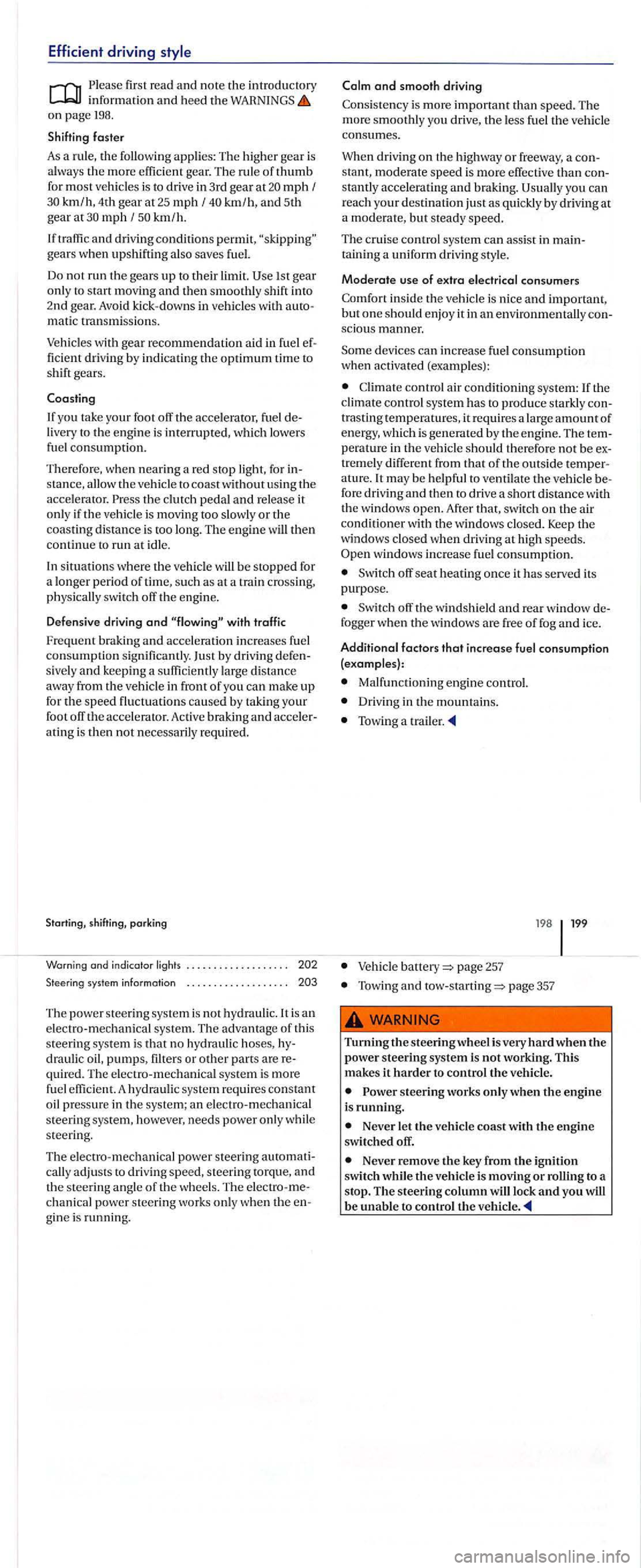
Efficient driving
Please information and heed the on page 198.
Shifting faster
As a rule, the following applies: The higher gear is
a lways the more efficient gear. The rule of thumb for most vehicles is to drive in 3rd gear at mph f km/h, 4th gear at 25 mph f km/h, and 5th gear at mph f km /h.
If
and driving conditions permit, gears when upshifting also saves fuel.
Do
not run the gears up to their limit.
mati c transmissions .
Vehicles with gear recommendation aid in fuel fic ient dri ving by indicating the optimum time to shift gears.
livery to the engine is interrupted, which lowers
fuel consumption.
T herefore, when nearing a red stop light , for s tanc e, allow the vehicle to coast without using the accelera tor. Press the clutch pedal and release it only if the v ehicle is moving too slowly or the coasting distance is too long. The engine will then continue to run at idl e.
In situati ons
where the vehicle will be stopped for
a longer period of time, such as at a train cros sing,
physically switch off the engin e.
D efens ive driving
and with traffic
Fre
quent braking and accel eration increases fuel consumption sign ific antly. Just by driving sivel y and keeping a su fficiently large distance away fro m the vehicle in front of you can make up for the speed fluctuation s caused by taking your foot off the accelerator. Active braking and ating is then not necessarily required.
system information
The power stee ring syste m i s not hydrauli c.lt is an electro-mechanical syste m. The advantage of this
s te ering system is tha t no hydra uli c hoses, draulic oil, pumps, filters or other parts are quired . Th e e lectro-m echanica l system is more fue l effi cient. A hydraulic system requires constant oil pressure in the syste m; an electro -mechanical
s teerin g sys tem, however, needs power only whil e
s teering.
Th e el
ectro-mechanical power steering
chanical power steering works only when the gin e is running.
and smooth driving
Consistency is more important than speed. The more smoothly yo u drive, the less fuel the vehicle consumes.
When driving on the highwa y or freeway, a
stantly accelerating and braking. you can r each your destinatio n just as quickly by driving at a moderate, but steady speed.
The c rui se control syste m can a ssis t in
sciou s manner.
Some dev ices can increase fuel consumption when activated (examples):
C limate control air conditioning system:
trasting temperatures, it requires a large amount of energy, which is generated by the e ngin e. T he
tr emely different from that of the outside
windows increase fuel consumption.
Switch off seat heating once it has served its
purpose.
Sw itch off the windshield and rear window
Malfunctioning engine control.
Driving in the mountains.
Towing a trailer .
page 257
Towing and page 357
Turning the steering wheel is very hard when the power steering system is not working. This makes it harder to control the vehicle.
steering works only when the engine is running.
Never let the vehicle coast with the engine switched off.
Never remove the key from the ignition
switch while the vehicle is moving or rolling to a
stop. The steering column will lock and you will be unable to control the vehicle.
Page 201 of 541
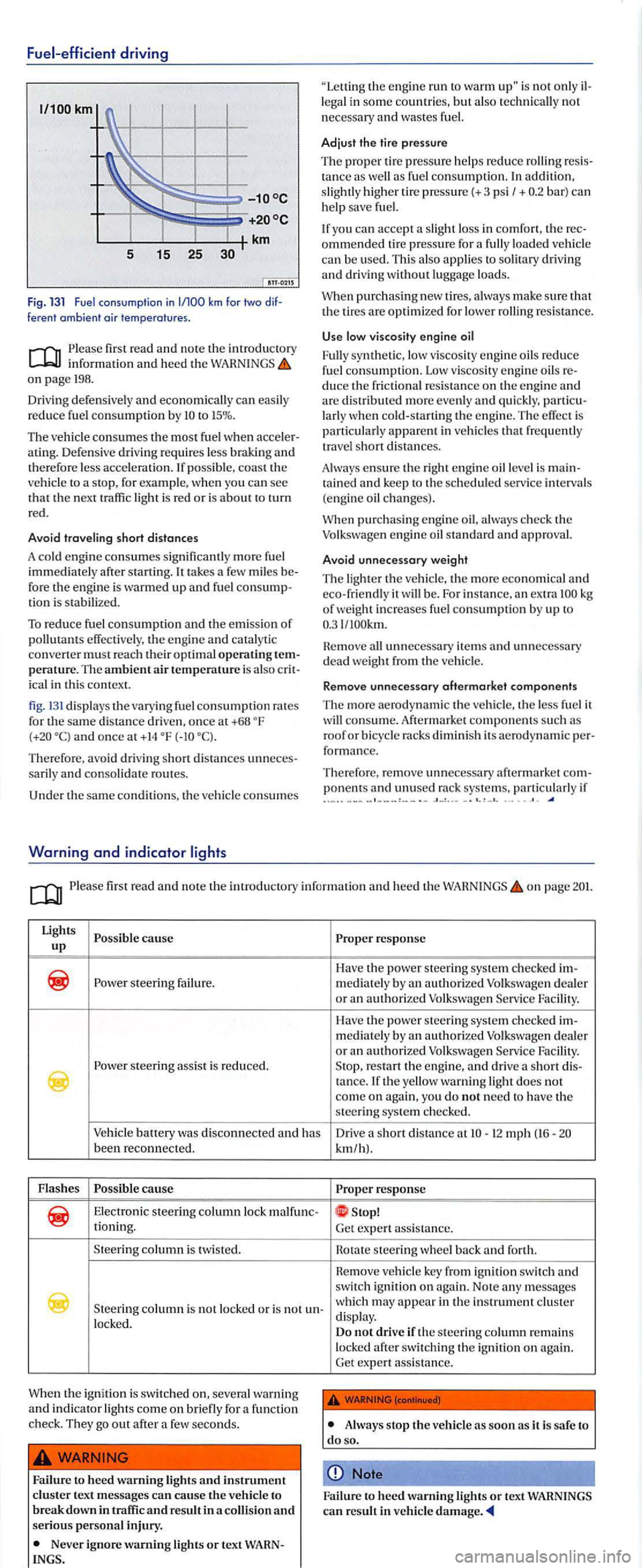
Fuel-efficient driving
Fig. 131 Fuel consumption in ferent ambient air temperatures .
info rmation and heed the on page 198.
Dri vin g defensive ly and economically can easily
r educe fuel con sumption by to 15 % .
The ve hicle consu mes the most fu el w he n atin g. D efe nsive dri vin g require s less brakin g and therefore less accelerat ion. If possib le, coast the ve hicle to a sto p, for exa mple, when yo u ca n see th a t th e next traffic ligh t is red or is about to turn
red.
Avoid traveling short distanc
es
A cold engine consumes sig nificantl y more fuel
imm ediately after sta rtin g. It take s a few miles fore the engi ne is warm ed up and fuel tion i s stabili zed.
To reduce fuel consumptio n and the emission of pollutants effect ive ly, the e ng in e and ca talytic
conve rter must reach th eir optimal operating
ica l in thi s context.
fig. 13 1 displays the v a ry ing fuel consumption rates
for the same d istance dri ven, once at +68 and once at + 14
th e e ngin e run to warm is not o nl y lega l in some co untries, but also technicall y not
n ecessary and wastes fu el.
Adjust the tire pres sure
T he prop er tir e
pressure help s reduce rollin g tance as well as fue l co nsumption. In additi on ,
slig htl y higher tire pressure(+ 3 psi I+ bar) ca n
h e lp save fuel.
If you ca n a ccept a slight los s in comfort, the ommend ed tir e pressure for a fully loade d ve hicl e
ca n be used. This als o applies to so litary dri vin g and driv ing withou t lu ggage loa ds.
When purchasing new t ires, alway s ma ke sure th at
th e tires are optimi zed for lower rollin g resis tance.
Us e low viscosity engine oil
F ull y sy nth e
tic, low viscosity e ngine oils reduce
fuel consumption. Low viscosity e ngin e oils duce the fric tional res istance on th e engine and are dis tributed m ore evenly and qui ckly, larly w hen co ld -s tarting the engine. The effect is parti c ularl y apparent in vehicles th at frequentl y
tra vel s hort dis tan ces.
A lways ens
ure th e righ t e n g in e oil leve l is ta in ed and keep to the sc h edul ed serv ice interva ls
(e ng ine oil ch an ges).
W
hen purch asing e ngine oil, always ch eck th e Volksw agen en gine oil standard and approval.
Avoid unnecessary weight
The lighter th e ve hicl e, th e more economica l and ceo-friend ly it w ill be. For in stance, an extra
H e m ove
consum e. Aftermark et co mponents s uch as
ro of or b icycle racks dimin is h its aerod yn a m ic fonnan ce.
Th erefo re, re
mov e un necessary aftermark e t ponents and unused rac k systems, parti cul arly if ....... -
fir st read and note th e introductory informa tion and h ee d th e WAHNINGS page
response
Ha ve the power stee rin g sys te m ch ec ked ste eri ng failure. mediatel y by an authori zed Volk swag en deale r
o r a n authorized Volk swagen
Fac ility. steeri ng ass is t i s reduced. re start the e n gine, and dri ve a sh ort tan ce. If th e yello w warning light does not
c o m e on again, you do not need to have th e
s te ering syste m ch ec ke d .
Vehicle battery was di sconnected and has Drive a short distan ce at 12 mph been reconnec te d . km/h).
F lashes re sponse
Elec troni c steering column lo ck malfunc -
which m ay appea r in the in strument clu ste r
di sp lay. loc ke d.
W
hen the i g nit ion is switc h ed on, seve ra l wa rnin g and indicator lights come on bri efly for a f un ction ch e ck . T hey go out after a few seconds.
Failure to
heed warning light s and in strument cluster text m essages can cause th e vehicl e to break down in t raffic and result in a collisio n and seriou s personal injury.
Neve r igno re warning lights or tex t
Do not dri ve if th e s teerin g co lumn remains
l ocke d switch in g th e ig niti on on aga in.
Ge t expert assis ta nce.
Alwa ys sto p the vehicl e as soon as it is safe to do so .
Note
Failur e to heed warning lights or tex t WARNINGS can res ult in vehicl e damage
Page 202 of 541
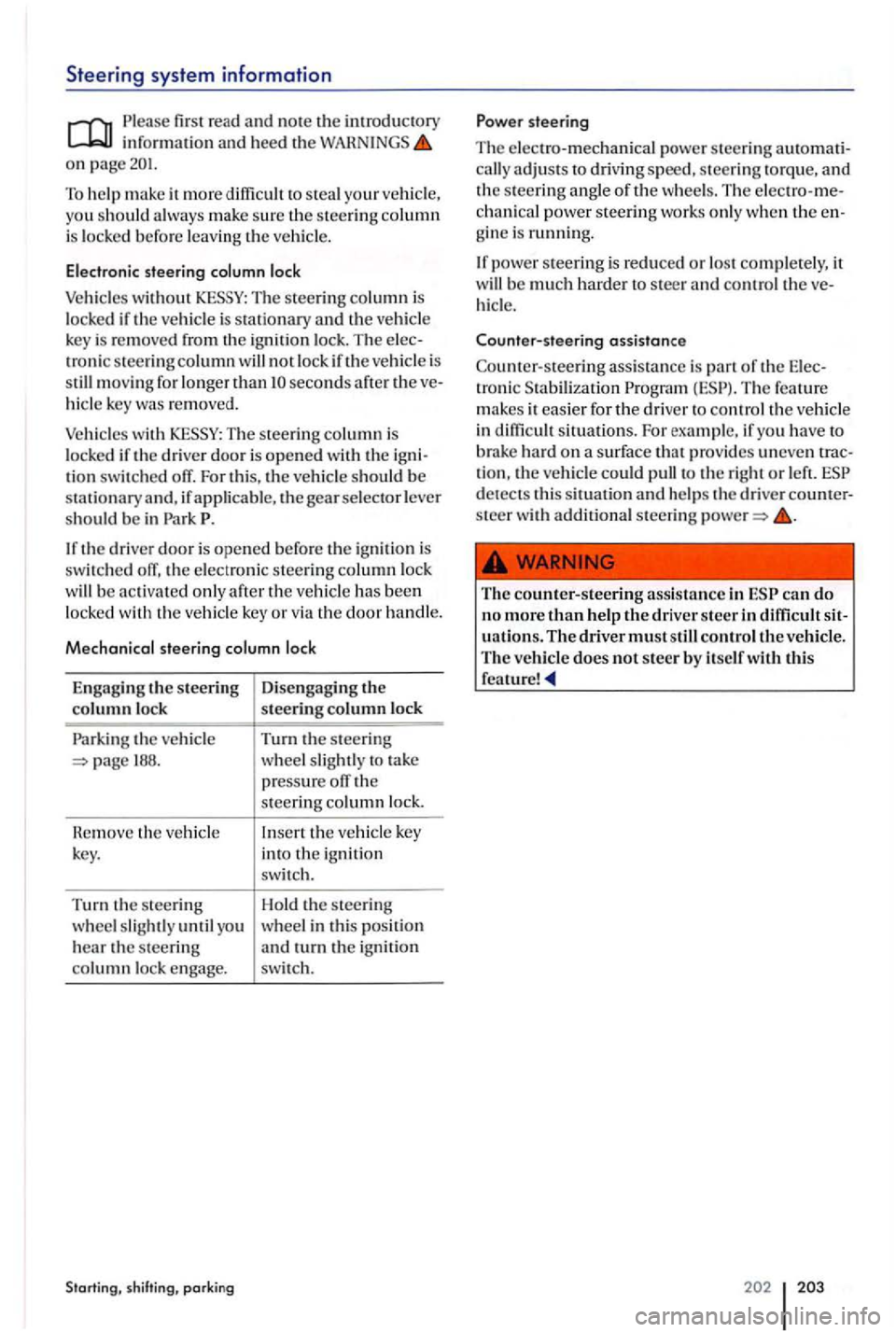
Steering system information
first read and note the introductory informatio n and heed the on page
To help m ake it more diffi cult to s teal your ve hicl e,
you sh ould always make sur e the steering co lumn is locked before leaving the ve hicle .
Electronic steering column lock
Vehicles with o
ut The s teering column is
l ocked if the vehicle is stationary and the vehicle
k ey is removed from the ign ition lock. The elec
tr onic s teering column will not lock if the vehicl e is
s till mov in g for longe r than seconds after the ve
hicl e key was re moved.
Vehicles with
Th e s teering column is
l ocked if the dri ver door is ope ned with the ignitio n switch ed ofT. For this, the ve hicle should be
s tationary if applic abl e, the gear selector leve r
s h ould be in
If the driver door is opened befo re the ign ition is
sw itch ed
188.
H e
move th e ve hicl e
k ey.
Turn th e s teering
w heel s lig htl y until you
hear the steering
column l oc k en gage.
Starting, shifting , parking
Disengaging the
steering column lock
Turn the s teering
whee l s lightl y to take pressure ofT the
s teerin g column lock.
In
sert the ve hicl e key
into the ignition swit ch .
Ho ld th e s teerin g
wheel in thi s pos ition
and turn the ignition switch.
steering
The e lectro-mechanical power steering auto m ati
c ally adjusts to dri ving speed, steering torque , and the steering angle of the wheels . The e lectro-me
c hanical power steering work s only w hen the en
gine is running.
If power steering is reduced or lost comple tely, it
will b e much harder to steer and co ntrol the ve
hicl e.
Counter-steering
assistance
T he feature
m akes it easier for the dri ver to control the vehicle
in difficult situation s. For exampl e, if yo u h ave to
brak e h
ard on a surface that provides uneve n t rac
tion, the ve hicle could pull to the right or l eft. detect s th is situation and h elps th e dri ver counter
s teer with additi onal steerin g
The counter-steering ass istance In
Page 218 of 541

Function and operation
Fig. 141 In the cen te r co nsole : b uHon fo r Dynomic C hoss is
Please read and note th e introductory inf ormati on and hee d t he on page 218.
D ynamic C hassis Control lets you prese lec t
chassi s dam ping for comfo rt or sporty driving .
pro grams.
T he
program also affec ts th e feel of the steering .
Driver assis tanc e systems
Program R
ecommended driving
Comfort- oriented setting, for driving on poor roa ds and driving lon g di sta nces .
Balanced
setting, for everyday
u se.
a program
o n th e ignition.
re p ea te dl y th e des ired progra m is
disp laye d.
Th e
nor illumin ated in the button. Turning off the
i g nition does no t chan ge the program you have lec ted.
Driv ing characteristics can
change after choosing chassis suspension setting. Drive just as carefully as you would if the vehicle did not
h ave Neve r let it tempt you into takin g
risks.
Always adapt your speed and driving style to
visibil and traffic condit ions.
malfunctions , flash in the button. Driving comfo rt might be affec te d b y th e malfunction. Tak e th e ve hicl e to an authorized Volk swage n
d ea ler or an authorize d Volkswa gen
218 219
Please read and note the introdu ctory information and h eed the WARNINGS on page
Poss ible cause or
Lights up and a chime sounds: Tire pressure is too in one o r more tires compa re d wi th th e ben chmark press ure
se t by the driver-or ti re has stru ctural
damage. A co rre spo ndi ng warning
sa ge may also app ear in the instrument cluster.
Fla s hes for abo ut seconds and then stay s on: malfun ction.
W h
en the ignition i s s witched on, severa l warning
a nd ind icato r light s come on briefly fo r funct ion
c h ec k. Th ey go out after a few seco nds.
Incorrec t lire pressures and/or under- inflati on can cause sudden tire failure , loss of control , lisio n, seriou s personal injury, o r even death.
When the warning symb ol
In correc t tir e pressure a nd/or tio n can ca use incre a se d tir e wear and ca n affe ct the handling of th e ve hicle and its stoppin g
Incor rec t tir e pressure and/or ti o n can also lead t o sudden tir e fa ilu re,
Proper response
Heduc e speed imm ediately! Always
s t
op th e vehicle as soon as it is safe do so . Avoid fas t cornerin g and hard braking!
tion press ure in all four tires. If th e tir e
cilit y c heck the sys tem.
(continued)
Always inflate tires to the correct tire re befor e drivin g off .
Driv in g with under-inflat ed tire s causes them to flex more, letting the m get too hot,
which can
Excessive speed and/or over loading can
ca use heat build -up, sudden tire failure , and lo ss of control.
If the tire pressure is too low or too high , th e tires wear prematurely and the vehicl e will
not handl e we ll.
If the tire is not and yo u d o no t h ave
t o ch an ge the tire or whee l immediat ely , drive a t
reduced spee d to the nearest serv ice station to
c h eck th e tir e pressure and add
Page 293 of 541
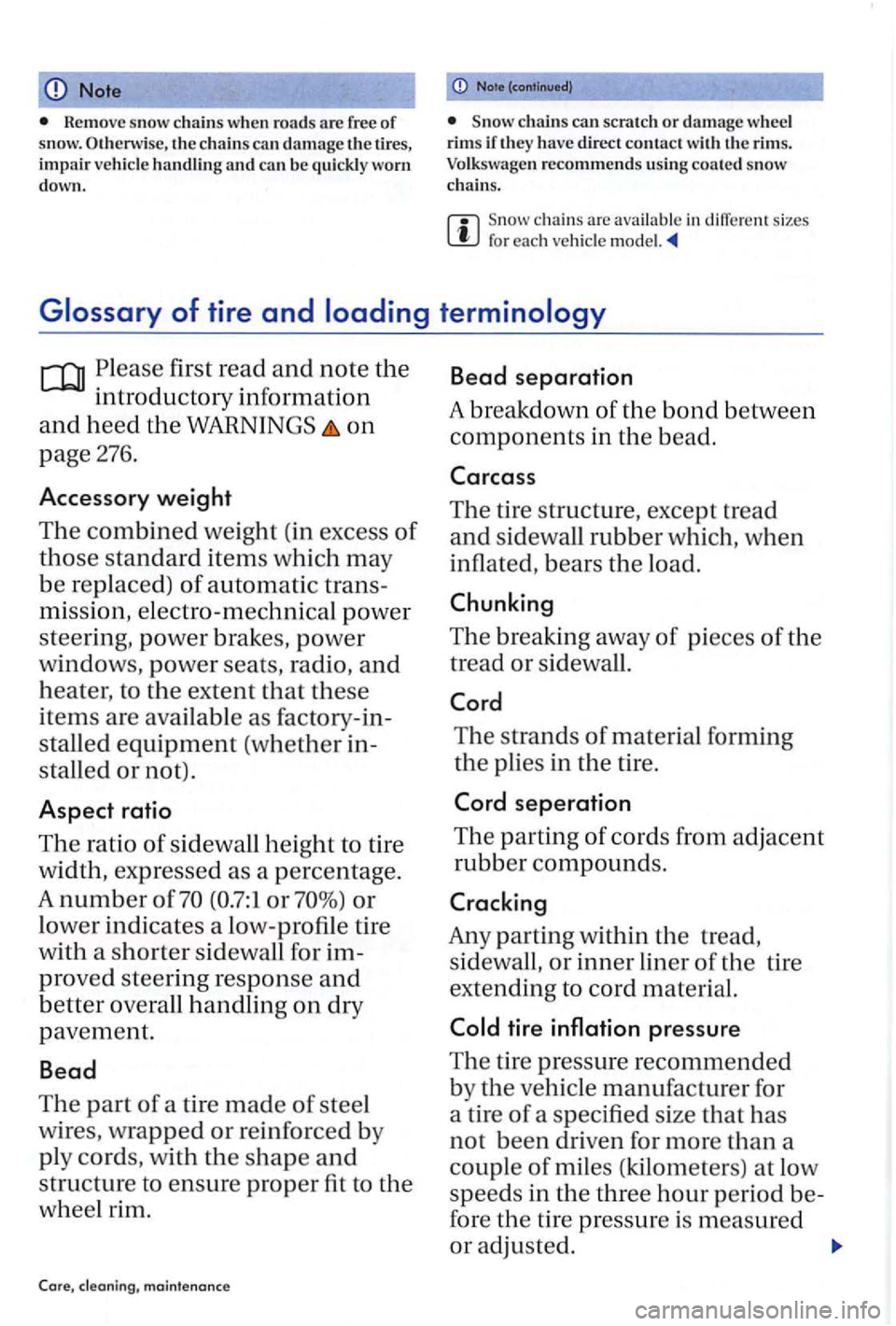
Note
Remove sno w c hain s w hen road s are free or snow. the chains ca n damage tires, impair vehicle handling and ca n be qui ck ly worn
down.
-------chain s they h ave direct contact w ith th e rims. Volk swage n recommend s usin g coa te d sn ow
chains .
c hain s are available in different sizes
Please first read and note the
introductory information
and heed the WARNINGS on
page 276.
Accessory weight
The combine d weight (in excess of
those standa rd items which may
be re placed) of automatic tra n s
mission, electro-mechnical power
stee ring, power brakes, power
windows, power seats, radio, and
heater, to th e extent that these
items are availabl e as factory-in
stall ed equipme n t (w hether in
s tall ed or not).
Aspect ratio
The ratio of sidewall heig h t to tir e
w
idth, expressed as a p ercentage.
A number o r or
lower indicates a low-profile tire
with a shorter sidewall for im
proved steering response and
better overall handling on dry
pavem ent.
Bead
The part of a tire made of steel
wires, wrapped or reinforced b y
ply cords, with the shape and
structure to en sure proper fit to the
w h
eel rim.
maintenance
Bead separation
A breakdown of the bond between
components in the bead.
The tire structure, excep t tread
and s id ewall rubber which, when
infl ate d, bears the lo ad.
The breakjng away of pieces of the
tread or sidewall.
The strands of materia l forming
the plie s in the tir e.
An y parting within the tread,
s id
ewall, or inne r lin er of the tire
ex te
nding to cord material.
at low
speeds in the three hour p e riod be
fore
the tire pressure is measured
o r a
djuste d.
Page 303 of 541
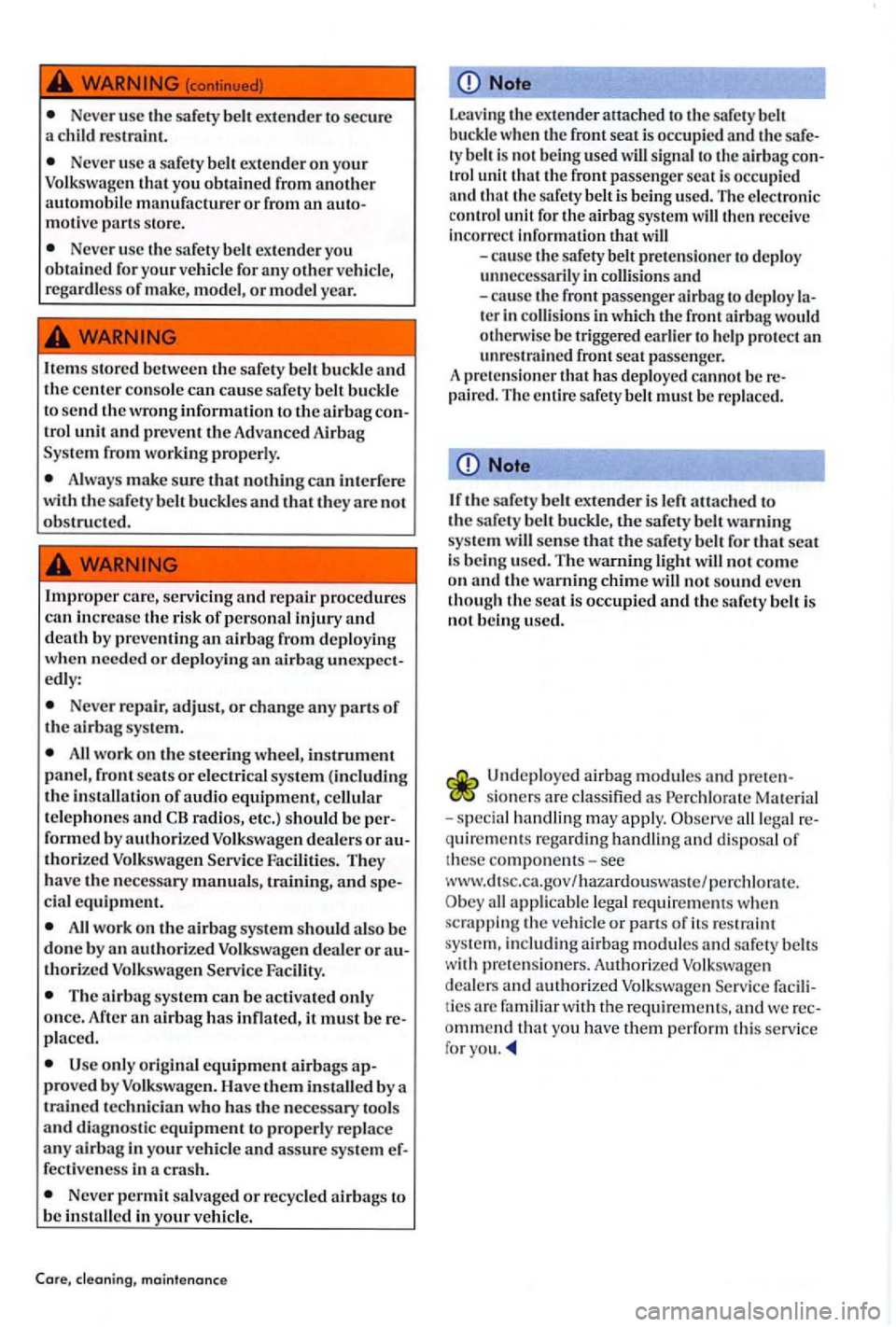
Never usc extender to sec ure
a chil d restraint.
Neve r usc a safety ex tender on your
motive part s store.
Neve r usc the safety exte nder you
obtained for your vehicl e for an y other ve hicl e,
r egardless of make, model, or model year.
It em s
store d between the safety
trol unit and prevent
Alwa ys mak e sure t hat nothing can interfere with the safety
needed or deploying an unexpectedly:
Never repair, adjust, or change any parts of the ai rbag sys tem.
All work on the steering whee l, instrume nt panel, fr ont scats or elec trical sys te m (in cl uding the installa tion of audio equip m ent, cellular te lephones and radio s, e tc .) should b e formed b y authorized Volkswagen dealers or thorized Volkswagen Service Faci lities. They have tl1c necessary manuals, tra inin g, and
All work on the ai rbag sys te m should also b e done by an Vo lk swag en d ealer o r
The alrbag system can b e ac tivated only
once. After an airbag has innatcd, it mus t b e placed.
o nl y o rigin al equipment airbags proved by Vol kswage n. Ha ve them installed by a
t ra ined technicia n who has the neces sa ry tool s
and d iagnosti c equi pm ent to properly rep lace
a n y a irba g in your vehicl e and ass ure sys tem fectiveness in a cras h.
Never permit sa lvaged or r ecycled airbags to
b e in stalle d in vehicle.
Care, cleaning, maintenance
Note-----
Leaving the extender attached to the sa fe ty belt
buck le whe n th e front seat is occu pied and the
ty belt is not being used will signa l to the airbag trol unit that the front passenger scat is occ upied
and that the safety belt is being use d. The e lectro ni c control unit fo r th e airbag system will then rece ive inco rre ct inf ormation that will -cau se the sa fety
ter in co llis ions in which the fro nt airb ag would
othe rwise be triggered earlier to help protect an
unr estrained front scat passenge r.
A pr etcnsio ncr th at h as depl oyed cannot be p air ed . Th e entir e safe ty belt mu st b e rep lace d.
Note
If th e safe ty belt extender is left attached to
th e safe ty belt buckle , the safety belt warning
sys tem will sense that the safe ty be lt for that seat is being used. T he warning light will no t com e
o n and th e warning will not sound even though th e scat is occupied and th e safe ty be lt i s
not being use d.
air bag module s and sio ne rs arc cla ssifie d as Pe rchlora te Mate ria l -special hand ling ma y apply. all le ga l quir em ent s regardi ng handlin g and dis po sal of th ese compone nts-see wlvw.dtsc.ca.gov/ha.zardouswas te/pcrchlom tc. all applicable legal requirements w hen
scmppi ng the vehicle or parts of its res tra int
sys te m , including airbag modules and safet y belts
w ith prctcnsio ne rs. A uthori zed Volk swage n
d ea lers and authori zed Volkswagen Service facili
t ies arc familiar with the requirements, and we yo u have them perform thi s se rvice for
Page 315 of 541

Do it yourself
con sid era tions" or may help.
De
scription causes amon g oth ers remed y
Vehicl e ba tt ery dead. jump page 353.
page 257. Engine does no t start. The wrong ve hicle key is used. a valid ve hicl e page 34.
Fuel leve l too low. Hefue l 234.
Batt ery in ve hicl e key dead. page 34.
Vehicle cannot be locke d Too far away from vehicle . Sy nchroni ze veh icle page 34. key. Lock or unlo ck vehicl e manually
crat ing range. page322.
en gine, braking assis t sys-th e entry in the ke yword noises. te rns, e lectro nic steering index.
co lumn lock.
the "Assis tance e ntry in the keywo rd in dex .
Exterior mirro rs move convenience settings
w he n unl ocke d . stored. 65.
F ront seats can not be ad -Vehicle battery dead. veh icle page 257.
jus ted with power con-Fuse b lown.
a n authoriz e d Volkswage n
m obilit y se t in vehicle. on ve h icl e. dealer or an authori zed Volk swagen Ser-
v ice Facility for page 326.
Func tions diff
er from th e Settin gs were adju ste d in th e and reset to fac tory settings if
descript ion in the oper-Volkswagen Information page 2 ating manual. Syste m.
T he road
is not illumi-H ea dlights a djusted too hig h . !>A dju st headlig ht page
n a ted correctly. Light b ulb s burned out. ligh t page 344.
Low beams no t swi tched on . Switch on low page
Vehicle battery ch a rge too low. page 257.
E lect rica l a p plian ces do Remaining fuel le vel too low. Refu el page 234. not functi on.
page341.
Do it yourself
Page 354 of 541
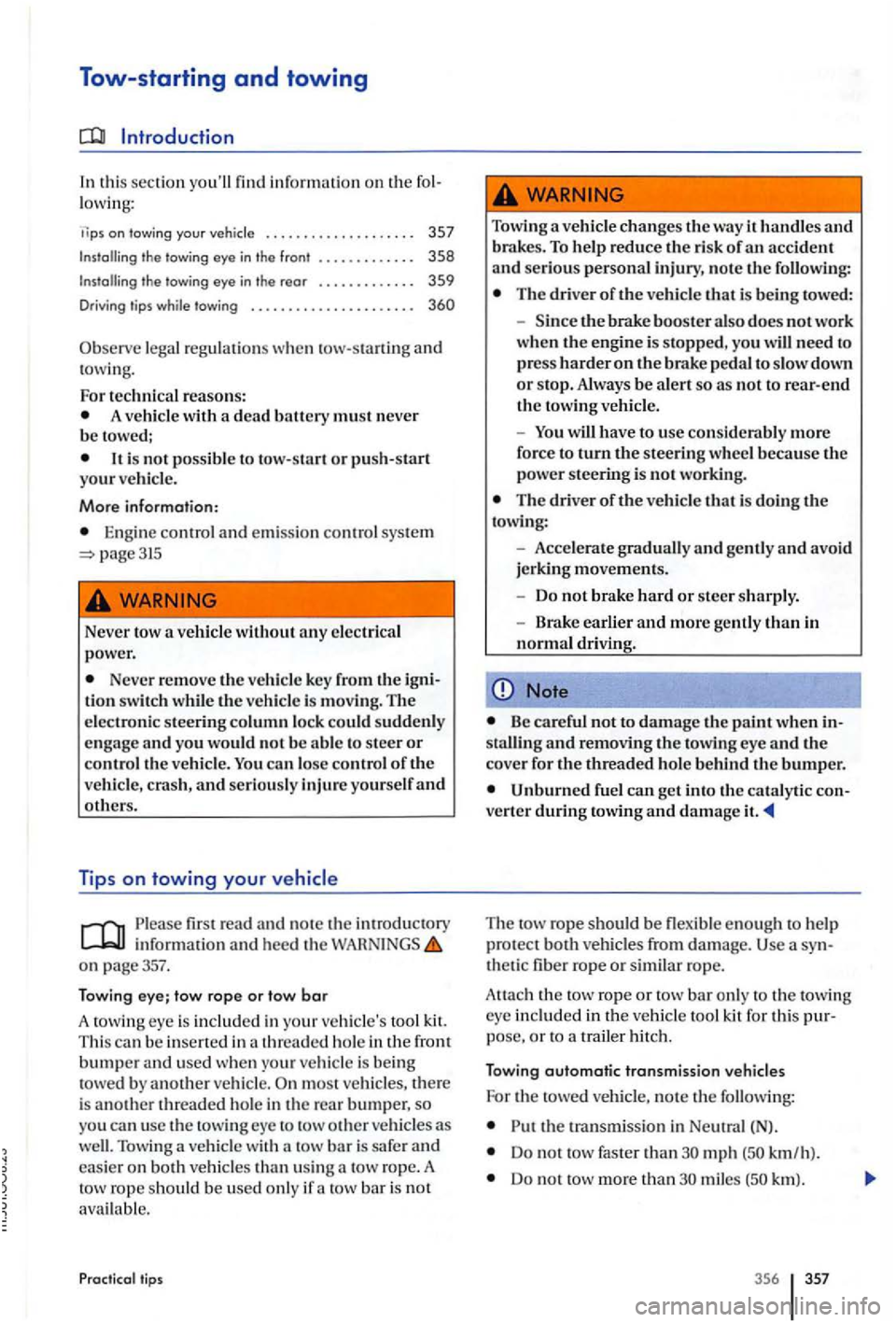
Tow-starting and towing
Introduction
In thi s sec tion you'll find informati on on the low ing:
ti ps on towin g your vehicle . . . . . . . . . . . . . . . . . . . 357
Installing the towing eye in the fron t . . . . . . . . . . . . . 358
In stalling the towing eye in the rear . . . . . . . . . . . . . 359
Driving tips while towing . . . . . . . . . . . . . . . . . . . . . .
Ob serve lega l regulations tow -startin g and
t ow ing.
For technical rea sons: A vehicle with dead battery must never be towed;
Engin e control and emissio n control system page315
Never tow a vehicle without any electrica l
power.
Neve r remove the vehicle key from the
first r ea d and no te th e introductory inf ormation and heed the WARNINGS on page357.
Towing eye; bar
A to w ing eye is includ ed in your vehicl e's tool kit.
Thi s ca n b e inserted in a th rea ded h ole in the front bumper a nd use d whe n your ve hicl e is bei ng
t owed by an o th er ve hicle.
Towing a veh icle change s th e way it handles and brake s. To help reduce the risk of an accident and serious personal injury, note the following:
The driver of the ve hicl e that is being towed:
-
need to
press harder on the brak e pedal to slow down or stop. Always be alert so as not to rear-end the towing vehicle.
-
You will have to use conside rably more
force to turn the steerin g whee l because the power steering is not working.
The driver of the ve hicl e that is doing the towing:
- Accelerate gradually
and gently and avoid
jerking movements.
- Do
not brake hard or stee r sharply.
- Brake earlier
and more gently than in normal driving.
Note
Be careful not to damage the paint when stalling and removing the eye and the cove r for the threaded hole behind the bumper.
Unburned fuel can get into the catalytic verter during towing and damage it.
The tow rope s ho uld be nexib le e no ug h to help
protect both v ehicle s from damage . thetic fiber rope or simil ar rope.
A tta ch th e
tow rope or tow bar onl y to the towing
eye included in the vehicl e tool kit for thi s
the transmission in Ne utra l (N).
Do not tow faster than mph km /h ).
D o not tow more than miles